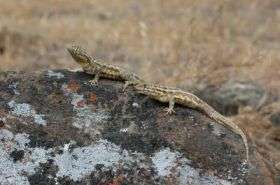Scientists look at those in evolutionary race who don't make it 'out of the gate'

In the race of evolution, scientists until now have only looked at winners and losers. Now, they’ve come up with a way to look at the contenders who never made it out of the gate.
It’s the organisms – in this case lizards – that die early in life, before scientists can even assess what they might bring to the reproduction game, and that have gone uncounted in the effort to quantify genetic fitness. This group has been dubbed the “invisible fraction.” Andrew McAdam, assistant professor of fisheries and wildlife and zoology at Michigan State University, has co-authored a paper in the Jan. 23 Proceedings of the Royal Society which brings that elusive fraction to light.
“Measuring the invisible fraction is important because some organisms don’t make it to adulthood,” McAdam said. “They lost the race before they even got out of the gate.”
McAdam and Barry Sinervo, an ecology and evolutionary biology professor at University of California – Santa Cruz, explored the invisible fraction in a study of side-blotched lizards appearing in a special issue of the journal about long-term studies of evolution in the wild.
Measuring this group is difficult, but the approach outlined in the paper shows it can be done when detailed pedigrees are available for the animals.
Sinervo, who is the lead author on the paper, has been studying side-blotched lizards in California for more than 20 years and has more than 7,000 lizards pedigreed in the same way as thoroughbred racehorses or prized cattle.
Sinervo and McAdam have figured out how many eggs a female would have laid even if she did not survive long enough to reproduce. The trick is to use this extensive lizard pedigree to see how many eggs her relatives laid.
This enabled them to measure the cost of producing large and small clutches of eggs during the process of maturation – even for the females that didn’t survive long enough to produce a clutch. A clutch is the number of eggs that a female produces at a single time.
“What we are really trying to estimate here is a female’s genetic value for her clutch size,” McAdam said. This genetic value is called a breeding value, and it is estimated by measuring a female’s clutch size and the clutch size of her sisters, daughters and other relatives.
“What we are searching for is that portion of a female’s clutch size that is reliably passed down across generations,” McAdam said. It is this genetic value that allowed Sinervo and McAdam to predict what a female’s clutch size would have been had she survived long enough to reproduce.
Surprisingly, they found that females producing large clutches often survived better as they matured than females with smaller clutch sizes, even though they are larger and slower when they are carrying eggs.
In a strange twist of gender bending, they also used this technique to see how clutch-size genes affected male survival during maturation.
“People may think this is a little crazy, but we can essentially do the same thing for males even though they don’t produce eggs,” McAdam said.
Clutch size is inherited, so males carry the genes for clutch size in their DNA. By measuring the clutch size of a male’s sisters and daughters, McAdam estimated the effects of genes that a lizard was carrying for this female trait. Even though they don’t have clutches, the same hormones that affect clutch size in females affect development and behavior in males.
In males, the hormones change how the lizards mature and cause them to interact differently with other lizards. These hormonal differences affect the survival rates.
The study found that male lizards, unlike females, survive better with the hormones that lead to small clutch sizes in females. This tug of war between the sexes is called “ontogenetic conflict.”
“The invisible fraction used to be a giant black box,” McAdam said. “With these new techniques, we are starting to be able to see inside.”
Source: Michigan State University



















